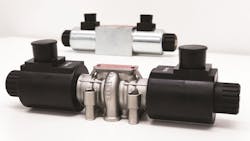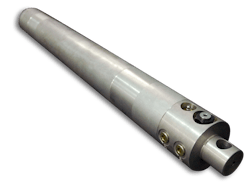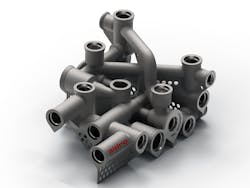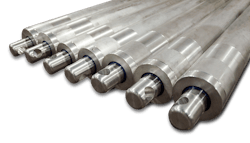Lightweight Hydraulics Offer New Opportunities to Manufacturers
Creation of lighter weight hydraulic components is increasing due to the many benefits which can be achieved. Mobile applications in particular can benefit from use of lightweight components as they can help to reduce the overall weight of the vehicle and thus improve fuel efficiency.
As electrification continues to grow, so too will the need for lightweight components. Not only can their use reduce overall vehicle weight, but they can also compensate for heavier components such as batteries and electric motors. “If you can offset that weight savings with a lightweight aluminum cylinder, especially in the hauling industry, it allows you to haul more product,” said Dwayne Skurat, Senior Design Technologist at RAM Industries. “And in the end, it allows you to have a smaller carbon footprint because now you're hauling more pounds for the same weight.”
Developing Lighter Weight Components
RAM developed its aluminum cylinder technology due to increasing demand from OEM’s for lightweight cylinders which could be used in trailer applications. The company can work with customers to create customized versions for use in trailer and a variety of other applications. It has also created a standard cylinder based on this market need and offers various options from which customers can choose for their own unique versions.
RAM’s cylinder features an aluminum body with several internal aluminum components, enabling it to be lighter in weight said Skurat. The cylinder also has a hollow rod, providing additional weight savings.
While there are other aluminum cylinders in the market, he noted many of them do not offer options or customization like the RAM cylinder does. Customization is a large part of what RAM does, which allows it to better meet customers’ specific application requirements.
Skurat said the aluminum cylinder has some unique features, one of which is porting being located at the base of the cylinder. This allows for a cleaner installation and a reduction in line length, as well as more protection for the cylinder lines depending on how it is incorporated.
A built-in check valve is available with the cylinder, as well, which locks the cylinder in place so it cannot move should its line break. And because the check valve is built into the cylinder, additional weight savings can be achieved as it eliminates the need for a separate valve block.
Additive manufacturing—also known as 3D printing—is one of the methods being utilized to create lighter weight hydraulic components. The secret of additive manufacturing is having the ability to change how manufacturers approach the design of their components and adopt the idea of additive manufacturing which essentially means add material only where it is needed, said Valeria Tirelli, President & CEO of Aidro Hydraulics & 3D Printing (a Desktop Metal company) and member of Power & Motion’s Editorial Advisory Board.
She explained that most conventional manufacturing for hydraulics starts with a metal block machined to create the desired design. However, with additive manufacturing (AM) the raw material—a metal powder—is continually added to create the product. This enables less material to be used than with conventional methods and thus reduces weight of the component.
“What is really important is to have the correct design for the additive manufacturing approach because we completely change the way we design the parts,” said Tirelli. Constraints normally associated with the design of hydraulics due to the limitations of conventional manufacturing methods can be completely removed, allowing more design freedom.
She said what Aidro discovered through the use of AM is that designs can begin with the desired flow of oil through the component. “We create the channel and then we add the material only where it is needed.” Depending on the pressure needed, more or less material can be added as necessary.
“The approach is completely different, we have a lot of freedom to create exactly the shape we need and the shape that will fit in the final hydraulics system,” said Tirelli. Parts can now be lighter and more compact, as well as better fit with the shape needed for the hydraulic system, connections, and tooling.
Material Options an Important Factor
Material choice can have a large impact on the creation of lightweight components. RAM said it chose to use aluminum as it is not only lighter in weight but also provides good corrosion protection. In addition, it does not require any painting which provides further weight savings as well.
Skurat said a wide range of aluminum grades are readily available in the market. With the many options available, RAM can machine different components and different strength materials to ensure they will work well within a given application.
Aluminum is also easily machinable, unlike some of the composite materials currently in the market. He noted aluminum is also more cost effective compared to some of the other lightweight materials available such as high-strength steels or composite materials which is beneficial as well.
Jeff Grabowski, Manager of Business Development, QuesTek Innovations, LLC—a provider of Integrated Computational Materials Engineering (ICME) technologies—said during a presentation he gave at the National Fluid Power Association (NFPA) Fluid Power Industrial Consortium’s (FPIC) March 2022 event there is a strong desire in the fluid power industry for lighter weight and thinner walled tubes and rods. However, buckling can become an issue.
To overcome this, he said companies could use higher strength steel. Fluid power component manufacturers could also utilize steels modified with ceramic particles which can improve stiffness and modulus of elasticity while maintaining strength. This would help to resist buckling and enable creation of thinner walled tubes or cylinders.
Cost, however, is a factor that would need to be considered. Steel can be expensive, and manufacturers will need to determine if using this higher cost material is worthwhile for their application. “We have found in many industries with certain components it is worth spending more money to get a better material to resolve your problem,” said Grabowski.
QuesTek has developed steels for applications where the increased cost is worthwhile, such as for aerospace and defense. For these, weight is a factor but so is strength which makes the higher cost worthwhile.
Development of Ferrium C61 and C64 carburizable steels, for instance, enabled the creation of transmission gears for army helicopters which were over 20% lighter in weight compared to the steels used previously. QuesTek was also able to design the steels to have a higher temperature resistance, allowing the gears to perform longer without the use of oil. “This is significant,” said Grabowski. “If the oil box is shot and the oil leaks, traditional steels’ microstructure breaks down, and you have maybe 10 or 15 minutes until it turns into butter and the helicopter crashes, but this material lasts for almost 90 minutes.”
Grabowski said the company is also working on a project with cast iron to see if it can improve the strength-toughness combination for lightweighting. The project is currently in the early stages but he said there is opportunity for improvements in cast iron development despite the material’s use over the last several centuries in many applications.
For some commonly used ductile irons, he said the company believes there is opportunity to modify the chemistries to increase strength or ductility which could allow for lightweighting or increased power density.
Lightweighting on a Growth Trajectory
As a variety of industries and applications—from passenger cars to agricultural machinery to aerospace—can benefit from use of lighter weight components, and particularly as electrification accelerates, their development will continue to grow in the coming years.
Skurat said currently lightweighting is a bit of a niche application but expects manufacturers will be looking for more lightweight solutions over the years. He said RAM wants to create alternate sizes and different combinations of rods for its aluminum cylinder design so it can be used in a variety of applications.
In addition, the company may look at creating a lightweight pneumatic cylinder based off the hydraulic design. He anticipates many of the components would be similar but with different sealing and layout. While many pneumatic cylinders in many applications are already made of aluminum, the push toward further lightweighting may increase its use.
“We are going to see growing requirements for [lightweighting],” concludes Darrell Mirva, Engineering Manager at RAM Industries. “We think it is a very promising field, and we see great benefits to the end users.”
About the Author
Sara Jensen
Executive Editor, Power & Motion
Sara Jensen is executive editor of Power & Motion, directing expanded coverage into the modern fluid power space, as well as mechatronic and smart technologies. She has over 15 years of publishing experience. Prior to Power & Motion she spent 11 years with a trade publication for engineers of heavy-duty equipment, the last 3 of which were as the editor and brand lead. Over the course of her time in the B2B industry, Sara has gained an extensive knowledge of various heavy-duty equipment industries — including construction, agriculture, mining and on-road trucks —along with the systems and market trends which impact them such as fluid power and electronic motion control technologies.
You can follow Sara and Power & Motion via the following social media handles:
X (formerly Twitter): @TechnlgyEditor and @PowerMotionTech
LinkedIn: @SaraJensen and @Power&Motion
Facebook: @PowerMotionTech

Leaders relevant to this article:





